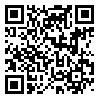BibTeX | RIS | EndNote | Medlars | ProCite | Reference Manager | RefWorks
Send citation to:
URL: http://jsaeh.khu.ac.ir/article-1-2874-en.html
2- environmental university
3- Waste and Wastewater Research Center, Department of Environmental Science, Islamic Azad University, Isfahan(Khorasgan) Branch, Isfahan, Iran.
Assessment of the Probable Impacts of Land Use Changes on Water Quality in Shadeghan
Wetland Using Remot Senseing Data
In this research, the evaluation of possible effects of land use change on water quality in Shadegan wetland has been provided with the help of remote sensing data. The purpose of this research was to evaluate and compare user variations in 2000 and 2015 using Landsat satellite imagery (with ETM and OLI sensors) from the study area and processing them in the ERDAS software environment using the unstructured classification method during a period of 15 years old has been investigated. To determine the cause of the changes occurring in the wetland, the water quality of the wetland was evaluated through the help of modeling. Vegetation in the wetland has been rising rapidly, indicating water pollution, an increase in the nutritional status and the early disappearance of this international wetland. With the help of this article, it can be admitted that the development of agricultural lands around the shadegan wetland from 2000 to 2015had caused an increase in pollution in the region, according to available agricultural wastement containing quantities of herbicides and pesticides which has led to an increase in the growth of algae in the wetland, which has led to an increase in temperature and eventually the death of wetlands and aquatic animals so after selecting images and assign them in 5 classes, the change wetland maps were obtained during a 15 year various sources were used to determine the best regression model for determining water quality changes in the following, the images were placed in the models and their mean and standard deviation were obtained. The result of the research showed that the Landsat sensor shows the water quality well and can be used to determine the changes. The development of agricultural lands leads to an increase in the eutrophication phenomenon in the wetland and, in the end, reduces the quality of water indicators. In the end, causes quality loss of water.
Key words: Assessment, Land Use Changes, Water Quality, Shadeghan Wetland, Remot Senseing.
Received: 2018/12/28 | Accepted: 2019/12/30 | Published: 2020/09/26
| Rights and permissions | |
 | This work is licensed under a Creative Commons Attribution-NonCommercial 4.0 International License. |






